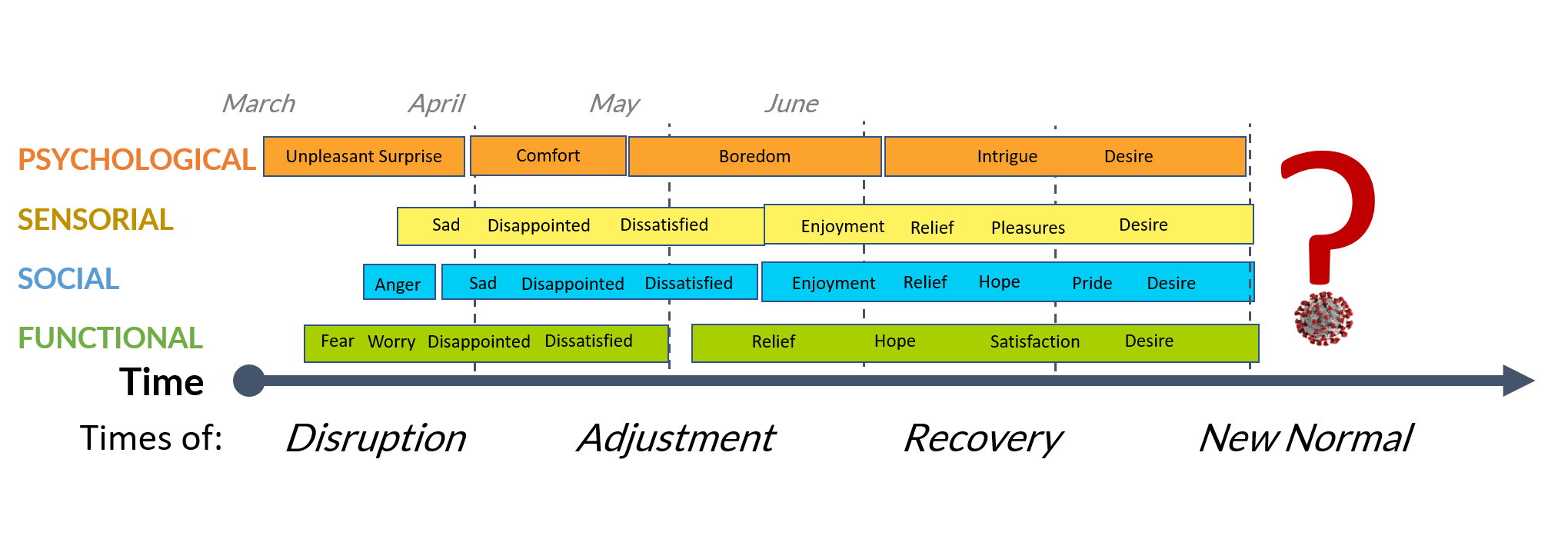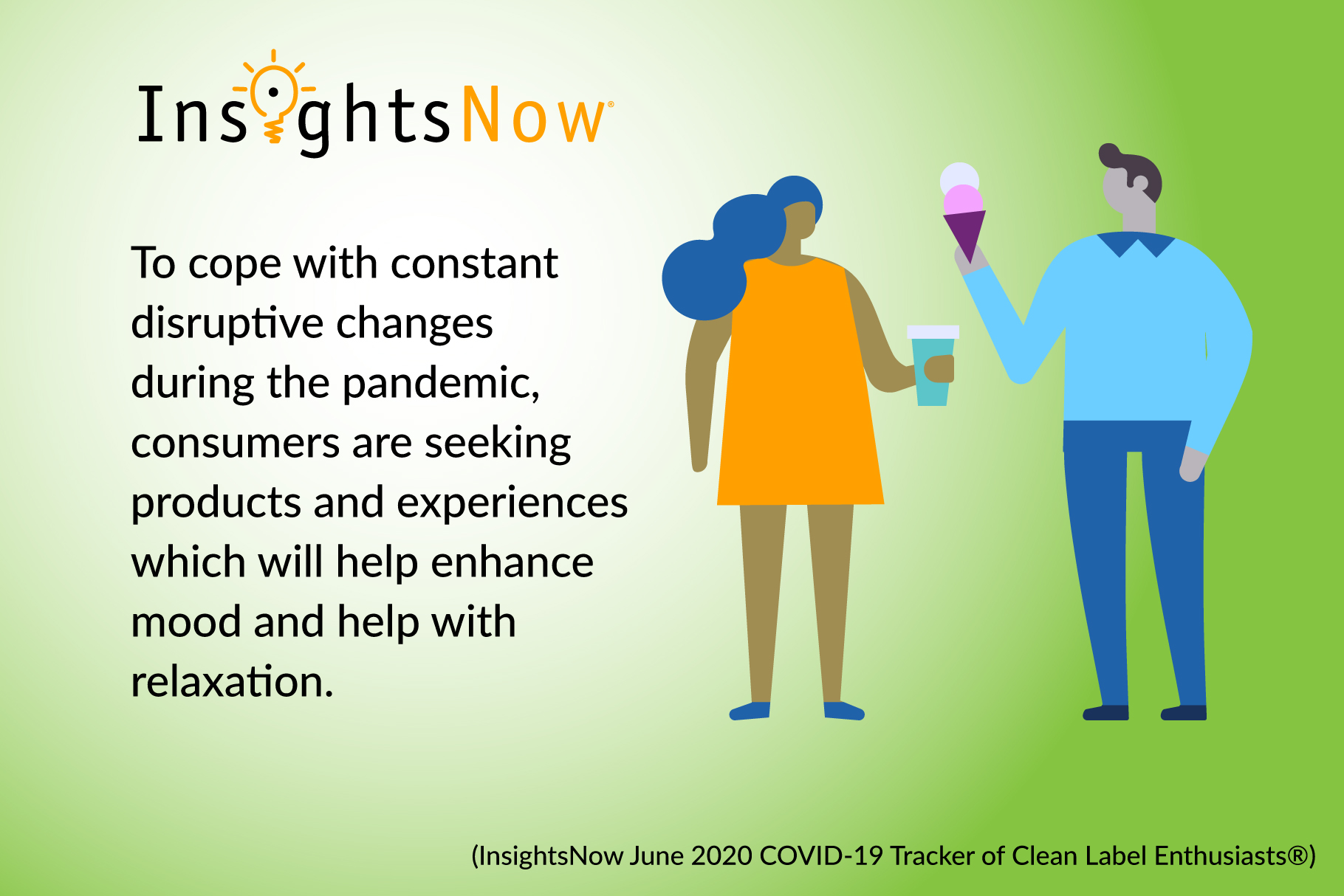How to gain insights into choice drivers during pandemic-related disruption
By Greg Stucky, Chief Research Officer, InsightsNow
The landscape of our lives has undergone incredible, seemingly unpredictable, change as COVID-19 continues to sweep the globe—and we have been in a state of constant revision for how we live, interact, work, play and shop. Yet amid the chaos there actually is a good amount of predictability to how these constant revisions take shape. By focusing on how people work through disruptions emotionally, InsightsNow has been able to leverage behavioral psychology to predict how people will react and how marketers and innovators can help them through their journey.
Consumer Emotions During COVID-19
All of us as a global society are working through emotions as we slowly define our own new normal. When COVID restrictions first began we all reacted with surprise, fear, and anger; many of us then moved on to sadness and disappointment. We started seeking comfort and were experiencing dissatisfaction in the alternatives we were forced to use due to the pandemic. A feeling of relief came when our favorite products were available again, but then came boredom with our situation and context. As stresses started to mount during these past months—and we realized this wouldn’t be over anytime soon—we started looking for ways to lift our mood and find enjoyment and relief. Some of us are settling in and looking towards the new and intriguing opportunities, but most of us still struggle to have hope and find new hope and new desires.

Predicting Consumer Behavior
How do we predict and examine behavior for brand success in a time when nothing seems predictable, and daily lives and expectations seem to change constantly in ways beyond comprehension? InsightsNow looks at emotional and behavioral frameworks to examine and foretell behaviors. The foundation of the emotional model most useful for this pandemic-related disruption starts with classifying the motivators of our choices into four categories: functional, social, psychological and sensorial.
-
- Functional Motivators are a central motivator right now as consumers feel their basic human needs are threatened—needs like safety, protection, health and preparedness.
- Social Motivators are important due to ongoing changes happening in family relationships, peer-to-peer social relationships, who we trust and our feelings toward ourselves.
- Sensorial Motivators are important as people look for products and experiences that help them cope—and potentially provide them with enjoyment and relief.
- Psychological Motivators are important in helping people achieve balance in their lives, and this psychological balance is achieved through mood change.
 In order to look more closely at these motivators, InsightsNow has been tracking insights from our proprietary, trend-identifying Clean Label Enthusiasts® (CLE) consumer research community. These ongoing study participants are primary shoppers with a specific set of behaviors around the clean-living movement, behaviors that strongly influence their buying decisions. Looking at this set of shoppers is helpful because this group has been shown to be at the forefront of identifying what is to come for the larger population. These shoppers offer rich insights into how brands and products need to communicate, shift and innovate to reach consumers during COVID-19.
In order to look more closely at these motivators, InsightsNow has been tracking insights from our proprietary, trend-identifying Clean Label Enthusiasts® (CLE) consumer research community. These ongoing study participants are primary shoppers with a specific set of behaviors around the clean-living movement, behaviors that strongly influence their buying decisions. Looking at this set of shoppers is helpful because this group has been shown to be at the forefront of identifying what is to come for the larger population. These shoppers offer rich insights into how brands and products need to communicate, shift and innovate to reach consumers during COVID-19.
Consumer Motivations During the Pandemic
While behaviors are changing, people are currently pre-occupied with the motivation to find a comfortable pattern in daily activities, activities which are ever evolving due to safety mandates put in place by external entities like governments and schools. This is keeping us constantly driven by a higher than typical level of Functional motivators—mostly a sense of safety. As this new and unexpected way of life continues, many are experiencing increased stress for a variety of reasons, some are struggling with isolation, others are feeling overwhelmed, and many are fighting varying levels of depression during this time. Stemming from these emotions, InsightsNow finds Social and Psychological Motivators are now outpacing functional motivators in the choices people make.
To cope with these constant disruptive changes, we are seeking products and experiences which will provide a pleasurable or relaxing distraction. Specifically, Sensorial Motivators have been found in InsightNow’s ongoing study to be growing in importance as consumers report an increased desire for products to satisfy sensorial cravings, and Psychological Motivators are now topping the charts as most important as we seek products which will lift our mood. For marketers, this means you can help improve consumers’ lives by introducing products which offer those benefits. For innovators, this means finding ways to add a delightful twist to the common brands they know and love.
 It’ll be a bit of time yet before everyone truly gets a sense of the new normal, when consumers start to truly desire completely new-to-the-world offerings and are ready to take on greater and more exuberant risks with products and experiences. However, monitoring emerging motivational patterns while studying consumer behavior through an emotional framework will lead to better predictions about when this will occur.
It’ll be a bit of time yet before everyone truly gets a sense of the new normal, when consumers start to truly desire completely new-to-the-world offerings and are ready to take on greater and more exuberant risks with products and experiences. However, monitoring emerging motivational patterns while studying consumer behavior through an emotional framework will lead to better predictions about when this will occur.







 In order to look more closely at these motivators, InsightsNow has been
In order to look more closely at these motivators, InsightsNow has been  It’ll be a bit of time yet before everyone truly gets a sense of the new normal, when consumers start to truly desire completely new-to-the-world offerings and are ready to take on greater and more exuberant risks with products and experiences. However, monitoring emerging motivational patterns while studying consumer behavior through an emotional framework will lead to better predictions about when this will occur.
It’ll be a bit of time yet before everyone truly gets a sense of the new normal, when consumers start to truly desire completely new-to-the-world offerings and are ready to take on greater and more exuberant risks with products and experiences. However, monitoring emerging motivational patterns while studying consumer behavior through an emotional framework will lead to better predictions about when this will occur.